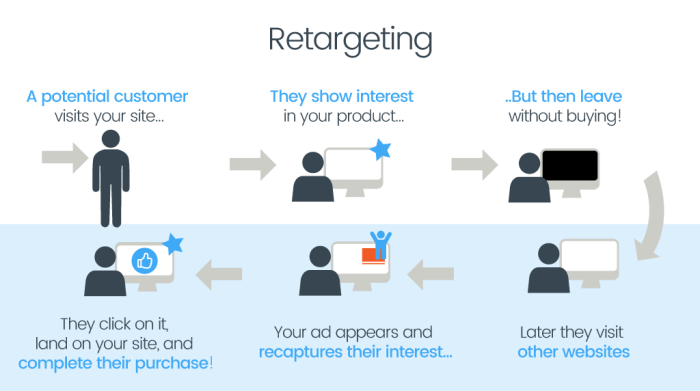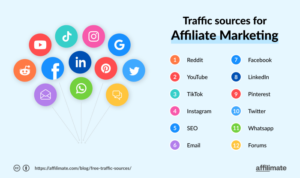Using Retargeting Ads opens up a world of possibilities in digital marketing, allowing businesses to reconnect with potential customers and drive conversions like never before. Dive into the realm of retargeting ads and discover how you can take your marketing efforts to the next level.
Introduction to Retargeting Ads

Retargeting ads are online advertisements that target users who have previously visited a website but did not make a purchase or complete a desired action. These ads work by using cookies to track users’ online behavior and display targeted ads to them as they browse other websites or social media platforms.
Retargeting ads are crucial in digital marketing strategies as they help businesses re-engage with potential customers who have already shown interest in their products or services. By reminding these users of what they were interested in, retargeting ads can increase brand awareness, drive conversions, and boost overall sales.
Importance of Retargeting Ads
- Retargeting ads help businesses reach out to users who have shown interest but did not convert initially.
- They can increase brand visibility and keep the brand top of mind for potential customers.
- Retargeting ads have a higher conversion rate compared to other types of online advertising.
- They allow for personalized messaging tailored to the user’s previous interactions with the website.
Examples of Successful Retargeting Ad Campaigns
Amazon: Amazon uses retargeting ads to remind users of products they viewed but did not purchase, leading to increased sales and customer engagement.
Netflix: Netflix uses retargeting ads to promote new shows or movies to users who have previously watched similar content, increasing user engagement and retention.
Zappos: Zappos uses retargeting ads to show users products they have viewed or added to their cart, encouraging them to complete their purchase and reduce cart abandonment rates.
Types of Retargeting Ads
Retargeting ads come in various forms to help businesses reconnect with potential customers who have shown interest in their products or services. Each type of retargeting ad has its own unique approach and effectiveness in reaching out to these leads.
Site Retargeting
Site retargeting involves displaying ads to users who have previously visited a specific website. This type of retargeting tracks users through cookies and shows them relevant ads based on their browsing behavior. Site retargeting is effective in reminding visitors about products they viewed but didn’t purchase, leading to increased conversions. Industries such as e-commerce, travel, and software services benefit greatly from site retargeting.
Search Retargeting
Search retargeting targets users based on their search queries on search engines. Ads are shown to users who have searched for specific s related to a business’s products or services. This type of retargeting allows businesses to reach users who are actively looking for what they offer, increasing the chances of conversions. Search retargeting works well in industries like real estate, education, and automotive.
Social Media Retargeting
Social media retargeting involves displaying ads to users who have engaged with a business’s social media content or visited their social media profiles. By retargeting these users with relevant ads, businesses can increase brand awareness and drive conversions. Social media retargeting is particularly effective in industries such as fashion, beauty, and food & beverage.
Email Retargeting
Email retargeting targets users who have interacted with a business’s email campaigns but haven’t taken the desired action. By sending follow-up emails with personalized content or offers, businesses can re-engage these users and encourage them to convert. Email retargeting is widely used in industries like SaaS, finance, and healthcare.
Setting Up Retargeting Campaigns

Setting up a retargeting campaign involves several key steps to ensure its success. From defining your goals to creating compelling ad creatives, here’s a breakdown of what you need to do.
Defining Your Goals
- Start by clearly defining your campaign objectives. Are you looking to increase website visits, boost sales, or promote a specific product/service?
- Identify the key performance indicators (KPIs) you will use to measure the success of your retargeting campaign, such as click-through rates or conversions.
- Determine your target audience and segment them based on their behavior on your website or interactions with previous ads.
Creating Compelling Ad Creatives
- Design visually appealing ads that align with your brand identity and messaging to grab the attention of your audience.
- Include a strong call-to-action (CTA) that encourages users to take the desired action, whether it’s making a purchase or signing up for a newsletter.
- Experiment with different ad formats, such as carousel ads, video ads, or dynamic product ads, to see what resonates best with your target audience.
Targeting the Right Audience, Using Retargeting Ads
- Use retargeting pixels to track user behavior on your website and create custom audiences based on specific actions, such as adding items to cart or visiting a particular page.
- Utilize audience segmentation to tailor your ad messaging and offers to different groups of users based on their interests and interactions with your site.
- Test different audience targeting strategies, such as lookalike audiences or retargeting based on time spent on site, to find the most effective approach for reaching your goals.
Measuring Success of Retargeting Ads: Using Retargeting Ads
When it comes to measuring the success of retargeting ads, it’s essential to focus on specific key performance indicators (KPIs) that can provide valuable insights into the effectiveness of your campaigns. By analyzing these metrics, you can make informed decisions to optimize your retargeting strategies for better results.
Key Performance Indicators (KPIs)
- Click-Through Rate (CTR): This metric measures the percentage of people who clicked on your retargeting ad after seeing it. A high CTR indicates that your ad is engaging and relevant to your audience.
- Conversion Rate: The conversion rate shows the percentage of users who completed a desired action, such as making a purchase, after clicking on your retargeting ad. It helps in evaluating the effectiveness of your ad in driving conversions.
- Return on Ad Spend (ROAS): ROAS calculates the revenue generated for every dollar spent on retargeting ads. It gives insight into the profitability of your campaigns.
Tools and Platforms for Tracking and Analyzing Performance
There are various tools and platforms available to track and analyze the performance of your retargeting ads. Popular options include Google Analytics, Facebook Ads Manager, AdRoll, and Criteo. These tools provide detailed insights into ad performance, audience behavior, and conversion data, allowing you to optimize your campaigns effectively.
Optimizing Retargeting Ad Campaigns
- Use A/B Testing: Experiment with different ad creatives, messaging, and audience segments to identify what works best for your campaign. A/B testing can help you refine your strategies based on performance data.
- Segment Your Audience: Divide your audience into specific segments based on their behavior, interests, or demographics. By targeting each segment with tailored ads, you can improve relevance and engagement.
- Monitor and Adjust: Continuously monitor the performance of your retargeting ads and make adjustments as needed. By analyzing KPIs and making data-driven decisions, you can optimize your campaigns for better results.








